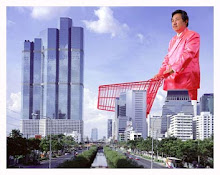The Journal of Contemporary Asia has made my extended discussion of the edited collection (Søren Ivarsson and Lotte Isager eds)
Saying the Unsayable: Monarchy and Democracy in Thailand (NIAS PRESS) freely available
Below is an excerpt that discusses the valuable contributions made by Jackson and Sarun to understanding the Thai monarchy
A God-King for Our Times or a Fetish Commodified?
The opening chapter of the book is Peter Jackson's important critique of the “virtual divinity” of the monarchy. The chapter fans out to question the predominantly Buddhist image of Thailand, following Pattana Kitiarsa's (2005) revisionist argument that understanding Thailand's religious culture requires seeing it as fundamentally hybrid and fluid, free of state control. It is this latter condition that provides some understanding to the re-deification of the monarchy in the late twentieth and early twenty-first centuries. Jackson argues that we can understand the near god-king status of Bhumibol only as a product of several related processes, including the “spectralisation” of the world in the neo-liberal era. Contrary to Weber's secularisation thesis, modernity has delivered a vibrant mysticism in the form of capitalist prosperity cults that aim to solicit the aid of the spirit world in aggrandising wealth. Spectralisation partly connotes that such spirits and ghosts come to have a real existence, they inhabit people's calculations, they are worshipped, solicited and they become manifest in symbols or are embodied in otherwise real people; time is no longer linear but people experience a world awash with ghosts of the past. The king who embodies the historical syncretism of Thai cultural practices would seem to be a spectral figure, and monarchy haunts the Thai imagination as an idea that transcends time. This cultural non-ideological texture of Thai mentalities recurs in forms that defy linear progression, the bricolage of traditions surrounding the monarchy being symptomatic. In that sense, monarchical politics are not always instrumental or consciously activated; they draw on a deep reservoir of Thai cultural being, if we take culture to mean a mélange of life practices subject to the tensions of power and freedom.
For Jackson the king has become spectralised as a divine figure. How this has come about is the subject matter of his chapter. As such, he furthers our understanding of the wide-eyed awe that some Thais have for the king. He shows how Buddhist discourses of dhammaraja that envisaged virtuous rule of the Buddhist monarch have gradually been supplanted, or perhaps cross-fertilised, with Brahmanic discourses of god-kings, with the latter becoming increasingly prevalent. The surprising element to Jackson's claim is how capitalist social forces – the money-seeking middle classes of shop owners and small workshop owners and, in part, the middle layers of the professional classes – have paved the way to this divination by imagining King Chulalongkorn (r. 1868-1905) as an ancestor spirit with special powers. The Chulalongkorn cult has been articulated to Bhumibol in some popular religious paraphernalia, and this emerging conflation of kings, a work still in hydra-headed progress, puts Bhumibol in a reflected aura. Not that he needs to bask in the glory of others, for the elements of god-king status have long been in place. Many Thais already assume the king to be a
sammuttithep, which Jackson describes as a “virtual deity,” a god by convention, rather than an actual god.
Sammutthithep, he explains, “is a key concept in Thailand's hybrid Buddhist-Brahmanic discourse in which royal power is legitimated by the king's ritual performance of godlikeness rather than from an ascription of literal divinity” (p. 38). For Jackson, the dual images of kingship are not simply parallel processes, for they bear some intimate relationship. He notes that in the Hindu pantheon of Gods, Buddha Gotama is the ninth incarnation of Vishnu. So rather than seeing contradictory processes of traditions of kingship that defy orderly progression, Jackson advances an understanding of differential permutations of religious lineages, adding up to a present in which the past is always there. The question now is whether the king has moved from this virtual realm of divinity to the real in popular belief? Indeed, it is not clear if this distinction has had much purchase even among some royal admirers (p. 39).
One way of testing this blurring of distinction is to ask what attributes of power attach to the monarchy. Jackson suggests that there are three notions of power operative in Thailand:
amnaat (raw power to act on things);
barami (charismatic power of the virtuous); and
saksit, described by Jackson as the “magico-divine power possessed by holy objects” (p. 33). Bhumibol is conventionally held to have an enormous store of
barami, in keeping with conceptions of Buddhist kingship, but in recent years
saksit has also attached to his person, giving him an aura of divinity. It is this development, Jackson (p. 34) contends, that enables Bhumibol to simultaneously aggrandise more raw power, against, we might add, a fourth notion of “procedural democratic power” that has emerged in struggles for democratic constitutionalism.
This god-making process is partly driven from below. Jackson tells the fascinating story of King Mongkut's conjuring of the protective deity Phra Siam Thewathirat to watch over the new capital in the nineteenth century (pp. 29-42), while noting that god-making around Bhumibol is no longer the preserve of the court. It has become demotic, for much of the holy view of the current king has been manufactured not in the workhouses of state identity agencies, but from the waves of mania and insecurity among social classes negotiating a pluralised spirit world and a life of commerce to create “occult economies.” If an early corporate aristocracy was suckled by the monarchy from the 1960s in highly specialised relationships (Gray, 1986 8), in a more developed form of capitalism it is fitting that a more numerous middle class seek favours by offering worship, whatever their chosen god.
For Jackson, what is most significant is that the state agencies have not resisted this process. Instead they have inserted the monarchy into the process by using “technologies of enchantment.” On this, contributor Martin Platt (p. 101) recounts seeing a video, set to modern folk music, on the Skytrain in Bangkok: “An elderly woman is showing reverential respects (or wai-ing) in front of a picture of the King. When her granddaughter asks who it is in the picture, the grandmother replies, “thewada thi mi lom hai jai” (a living, breathing angel). Visitors to Thailand are now greeted with a video presentation while waiting in line at the passport desk, telling them that the king “sees possibilities that no one else sees.” Such depictions depart from the more prominent rational discourses surrounding Buddhist kingship popular in the 1960s and 1970s, when both military dictatorships and elected governments sought to end people's reliance on superstition and the spirit world. Of the political impact of the new divinity surrounding the monarchy, Jackson notes that those who have promoted rational images of kingship and constitutionalism – advocates of “royal liberalism” – have done very little to protest these developments, viewing as they do the monarch's apparent anti-materialism as a support against the corrupt money politics that troubles them (p. 51). In as much as the monarchy is now a cult, the cult is about a spirit/ghost-in-the-world which is beyond control. In all, Jackson's piece helps greatly in imagining a social and anthropological place of the monarchy beyond the instrumentalism that some commentators have sometimes largely attributed to it.
The pseudonymous Sarun Krittikarn (Chapter 3) offers a counter-point to spectralisation by suggesting an inter-subjective reading of the monarchy that strips away the aura produced by the divination processes explored by Jackson. For Sarun, the king has become part of what he calls “entertainment nationalism.” This is defined as “a kind of nationalism channelled through the fleeting and volatile desires and emotions of sensation gathering and pleasure seekers” (p. 63). Sarun explores how the inter-subjective gaze between king/royals and subjects instantiates an identity in subjects that is dependent and childlike. In effect, the claim is that observance of royal performance can lead to the internalisation of the propagated discourse of family-like relations between the parental royal family and the childish subject. Just as the process implores the royal family to continually perform itself in royal guise, so the king has become a logo “easily turned into a fetishized commodity” (p. 77). For some, the king's gaze is “warm, protective, forgiving, full of self-sacrificing love and care” (p. 69). Still, for others, the gaze can involve “total subjugation to superior power” (p. 69). Sarun is at her/his interpretative best describing the celebrations of the King's sixty-year reign in June 2006:
At that moment [when a photo was taken by a member of the royal family during the 2006 celebrations] the abstract sadomasochist relationship was materialised into a tangible object of the photograph, the individuality of the people in the Royal Plaza was temporarily dissolved into a mass uniform larger Self the self of being Thai, under the protective royal patronage (p. 70).
Here, as Sarun notes, the gazer is the king looking out at the masses. He is the subject who provides the foundation of the collective subject of the nation. It/they in turn look back, getting a shot of nationalism refracted through the monarch. They see themselves. This electrifying essay carries with it the burden of all cultural critiques influenced by the aesthetics of the Frankfurt School on modern mass culture – its assumption of a mass psychology and a thinly disguised distaste of mass processes. So the conclusions should be read as critique, not empirical reality.
Sarun's essay touches on themes explored at a 2008 photographic exhibition entitled Waiting for the King, by Manit Sriwanichpoom, at the Centre for Contemporary Photography in Melbourne, Australia. Taken while a massive crowd waited for Bhumibol to appear during the 2006 June celebrations, the pictures are long, thin and grey. They show a tired heat-stricken people, some brushed by a slight wind. Rusty street barriers exclude the people from the path of the imminent royal procession. Despite the presumably joyous occasion, worrisome and furtive looks make up the bulk of dispositions. Is this a corralled people waiting for a glimpse of divinity or a people waiting for their own brand of entertaining nationalism? The gaze then might be in the eye of the beholder. Manit set the exhibition on opposing walls so that when viewers walked through the space it was as if they themselves were in the procession, perhaps becoming Sarun's looked-at-king who is fashioned by a disturbing assembly of people and consumers. Coming to the end of these images, viewers gazed upon enlarged photographs of children tied and bound in Thai flags. Further still, viewers confronted a picture of a slit-throated chicken hanging above the flag and dripping blood. And finally viewers were confronted by the jarring image of a pig's heart so red it could still be pumping, sitting nonchalantly on the flag. The image symbolises, perhaps, the entirety of the processes that have led to an exclusionary and corrupt politics of all nationalisms, not just the Thai brand (Manit, 2008 20)
The tensions between the varied reading of the monarchy by Jackson and Sarun are evident. How can we align the occult magico-power of the divine kingship as spirit in the world with the mundane gaze of gossip and celebrity implied by entertainment nationalism so stridently described by Sarun? That both authors seem to be saying contradictory things and yet are able to offer convincing accounts reflects the monarchy's multiple registers and interactions with different, and frequently even opposed, audiences.





